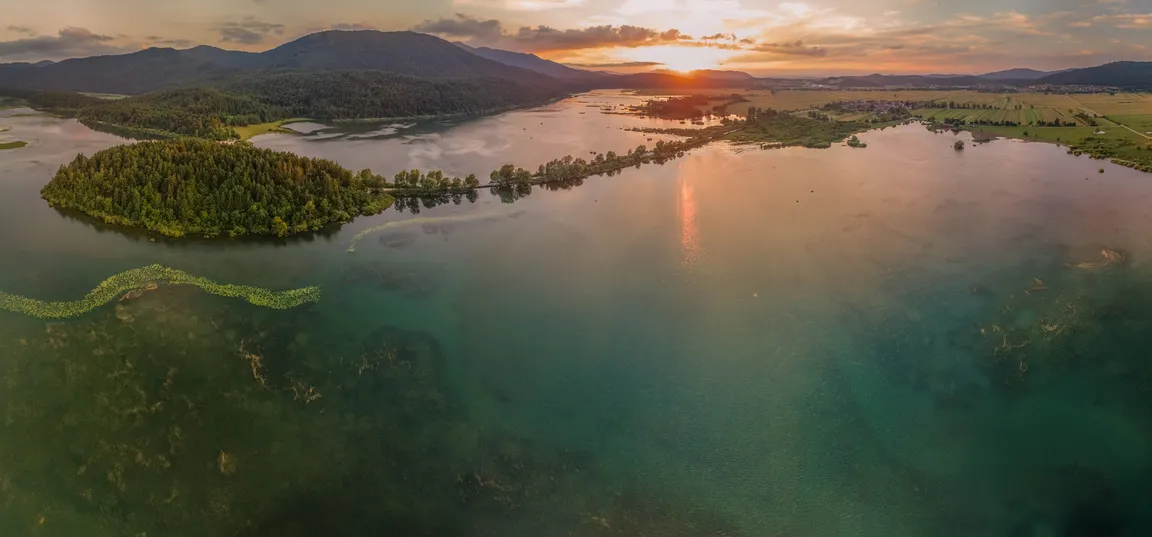Among the inland waters belong flowing and standing fresh waters, both natural and anthropogenic in origin, i.e., the work of human hands. Among standing fresh waters we count natural and artificial lakes, ponds, backwaters, reservoir lakes and also puddles, channels and drainage ditches. In and around these bodies of water there may be developed aquatic or shore vegetation, or the water bodies and their banks may remain unvegetated.
Among flowing waters we count all permanent and intermittent watercourses, i.e., rivers, streams, as well as torrents, waterfalls and rapids. The watercourses themselves are divided according to fall, bed width, water temperature and distance from the source. This division splits watercourses into belts according to the characteristic fish species that inhabits this part of the watercourse. From the source toward the mouth of the watercourse, the trout belt, the grayling belt, the barbel belt and the bream belt follow. The other division, however, is based on the type of vegetation on the banks or in the bed of the watercourse.
A very special type of continental waters, which are usually present on karst fields, are intermittent lakes. These are usually flooded for part of the year and dry for the rest. In the watery phase there is aquatic vegetation, in the dry phase, on the lake bed, completely terrestrial vegetation develops, i.e., terrestrial habitats.
Karst intermittent lakes and plains
Among intermittent lakes we count areas that fill with water after prolonged rainfall or after snowmelt, and during the dry part of the year the water from the lakes drains away. The bottom of intermittent lakes can be overgrown with grasses in the dry phase, or it may remain permanently moist or partly flooded throughout the year, and therefore aquatic, amphibious, boggy or swamp vegetation develops there.
Lake Cerknica is the largest intermittent lake in our country and one of the largest in Europe. It fills from underground, usually in autumn, after prolonged rainfall and during spring rains, when part of the water also comes from melting snow on Javorniki and Slivnica. It is filled by springs at the edge of the lake and estavelles on the lake bed, which, in the absence of water, also swallow it, just as swallow holes do. The same is true for Planinsko polje.
During the warm part of the year, on the bottom of Lake Cerknica there flourish extensive reed beds and clusters of tall sedges; on higher-lying parts and along its edge, extensive marsh meadows and low bogs green up. In the channels of the watercourses that wind through Lake Cerknica, the water remains the longest, therefore aquatic vegetation is developed there; on the banks of meanders and near swallow holes, where soils stay wet the longest, bog and amphibious vegetation spread.
Many plant species found in Lake Cerknica are tied to swamp habitats that are very sensitive, especially to human disturbances; therefore many are considered endangered and, with the continuation of threatening factors, face extinction!
Higher aquatic plants or macrophytes, as mentioned, thrive in the channels of the waters of Lake Cerknica. Among them are, for example, yellow water-lily (Nuphar lutea), white water-lily (Nymphaea alba), various species of pondweeds (genus Potamogeton), the dissected-leaved water crowfoot (R. circinatus) and the common bladderwort (Utricularia vulgaris).
Amphibious plants are adapted to both aquatic and terrestrial growth, as they adjust to the transition from water environment to land when the water recedes by changing their anatomy and function. In this way they are competitive with both aquatic and land plants. Some characteristic amphibious plants that thrive on Lake Cerknica include water horsetail (Equisetum fluviatile), European water plantain (Alisma plantago-aquatica) and grass-leaved water plantain (Alisma gramineum), flowering rush (Butomus umbellatus), common mare's-tail (Hippuris vulgaris), water smartweed (Polygonum amphibium), great yellow cress (Rorippa amphibia), great water-parsnip (Sium latifolium) and only a few others.
Characteristic bog species of Lake Cerknica include, for example, Carex davalliana (Davall's sedge) and yellow sedge (C. flava), common (Eriophorum angustifolium) and broad-leaved (E. latifolium) cotton-grass, oblong-leaved sundew (Drosera intermedia), white beak-sedge (Rhynchospora alba), common bogbean (Menyanthes trifoliata) and black (Schoenus nigricans) and brown (S. ferrugineus) sedge.
Meadows are the richest habitats in terms of plant species on Lake Cerknica. In moister soils among others we find common marsh-marigold (Caltha palustris), summer snowflake (Leucojum aestivum), yellow iris (Iris pseudacorus), early marsh orchid (Dactylorhiza incarnata), marsh orchid (Orchis palustris), great burnet (Sanguisorba officinalis), fen ragwort (Senecio paludosus), the devil's-bit scabious (Succisa pratensis), jointleaf rush (Juncus articulatus) and alpine rush (Juncus alpino-articulatus), bog dandelion (Taraxacum palustre) and lesser spearwort (Ranunculus flammula).
On the meadows at the very edge of the floodplain we find Carex panicea (carnation sedge), brownray knapweed (Centaurea jacea), shining spurge (Euphorbia lucida), northern bedstraw (Galium boreale), marsh gentian (Gentiana pneumonanthe), wild gladiolus (Gladiolus illyricus), tufted grass (Holcus lanatus), oxeye daisy (Leucanthemum ircutianum), dyer's plumeless saw-wort (Serratula tinctoria), marsh valerian (Valeriana dioica), the devil's-bit scabious (Succisa pratensis), ragged robin (Lychnis flos-cuculi), purple moor-grass (Molinia caerulea), common bird's-foot trefoil (Lotus corniculatus) and many others.


